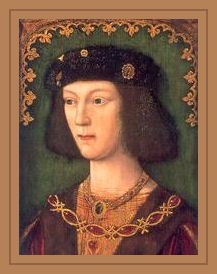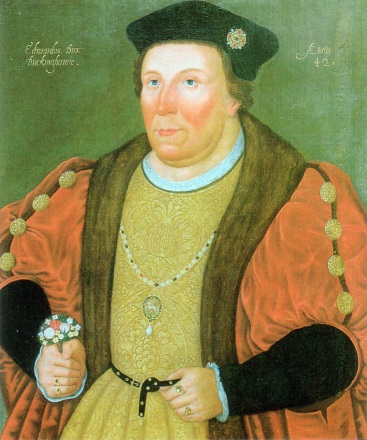The Tudor Succession Problem
Chapter 3 : Henry VII
Once established as King, Henry VII quickly concluded his half of the deal with the Yorkist supporters who had preferred him to Richard III. He married Elizabeth of York and united their claims, depicted pictorially in a flowering of Tudor roses that carpeted every conceivable surface. Efficient in everything, Henry got down to the business of providing a male heir, and some eight months after the wedding day the new King and Queen hit the jackpot first time with a healthy son.

Arthur, who was to be the embodiment of a new age, was followed by Margaret, Henry, Mary and Edmund. This royal nursery was not the least of the advantages that Henry could show in the face of efforts to pluck his crown away by the Lambert Simnel and Perkin Warbeck rebellions. Both of these were attempts by die-hard Yorkists to reinstate the line of Richard of York. Unfortunately, neither of their puppets were entirely convincing as the long-lost princes (although the identity of Perkin Warbeck continues to raise speculation.) Other attempts by the nephews of Edward IV, the sons of Elizabeth, Duchess of Suffolk, to claim the throne, never really got off the ground.
In 1499, Henry and Elizabeth could feel absolutely satisfied that they had done their job – three sons and two daughters living. Henry could begin to plan marriages for them to have a new generation of heirs lined up as soon as possible. Arthur was already accounted for – since the Treaty of Medina del Campo in 1489, his bride had been waiting for him. Katharine, daughter of the Catholic Kings of Spain was to be dispatched to England as soon after her fifteenth birthday as possible, that is, any time after December 1500.
But things began to go wrong. The King and Queen’s youngest son, Edmund, Duke of Somerset, died, aged not quite two years old. Then, in the worst nightmare that could befall them as monarchs and parents, their eldest son, Arthur, died soon after his marriage, in April 1502. The succession, from having looked safe only three years before, was now decidedly shaky, and there was a good deal of speculation about who would succeed him. A number of men were named, including the Duke of Buckingham (yet another twig on Edward III’s enormous family tree) as well as the de la Pole brothers. Ominously, Henry’s eleven year old second son did not seem to figure in men’s minds.

With some haste, Henry and Elizabeth made an attempt to restock the royal nursery, but the effort failed. In February 1503, Elizabeth died in childbed with her baby, Katherine. Henry was distraught, both as a man, and as a King.
In the six remaining years of his reign, he made motions towards finding a new wife, but it is difficult to believe his heart was really in it. With three children and a wife lost in as many years, and his daughter Margaret sent to Scotland at the age of thirteen, Henry became morose and depressed. All was not lost, however. His second son, Henry was growing up tall and strong and people now spoke of him as the heir. The succession was assured, at least for one transition of the Crown.
The first five in the line of succession at Henry VII’s death were his children, Henry, Margaret and Mary, followed by his wife’s sister, Anne of York, married to Thomas Howard, Earl of Surrey, but with no children, then Katherine of York, married to William Courtenay, Earl of Devon, with two sons.
There was a complication, in that the supporters of Richard III had claimed that Edward IV’s children (including Elizabeth, Anne and Katherine) were illegitimate. If they were ignored, there was Margaret Plantagenet, Lady Pole, (later Countess of Salisbury) the daughter of Edward IV’s brother, and sister to the late Earl of Warwick. There were also the descendants of Edward IV’s sisters, or more distantly, the numerous other descendants of Edward III – all with females in the line.
Henry VII’s descendants may be found here
Henry VII
Family Tree
